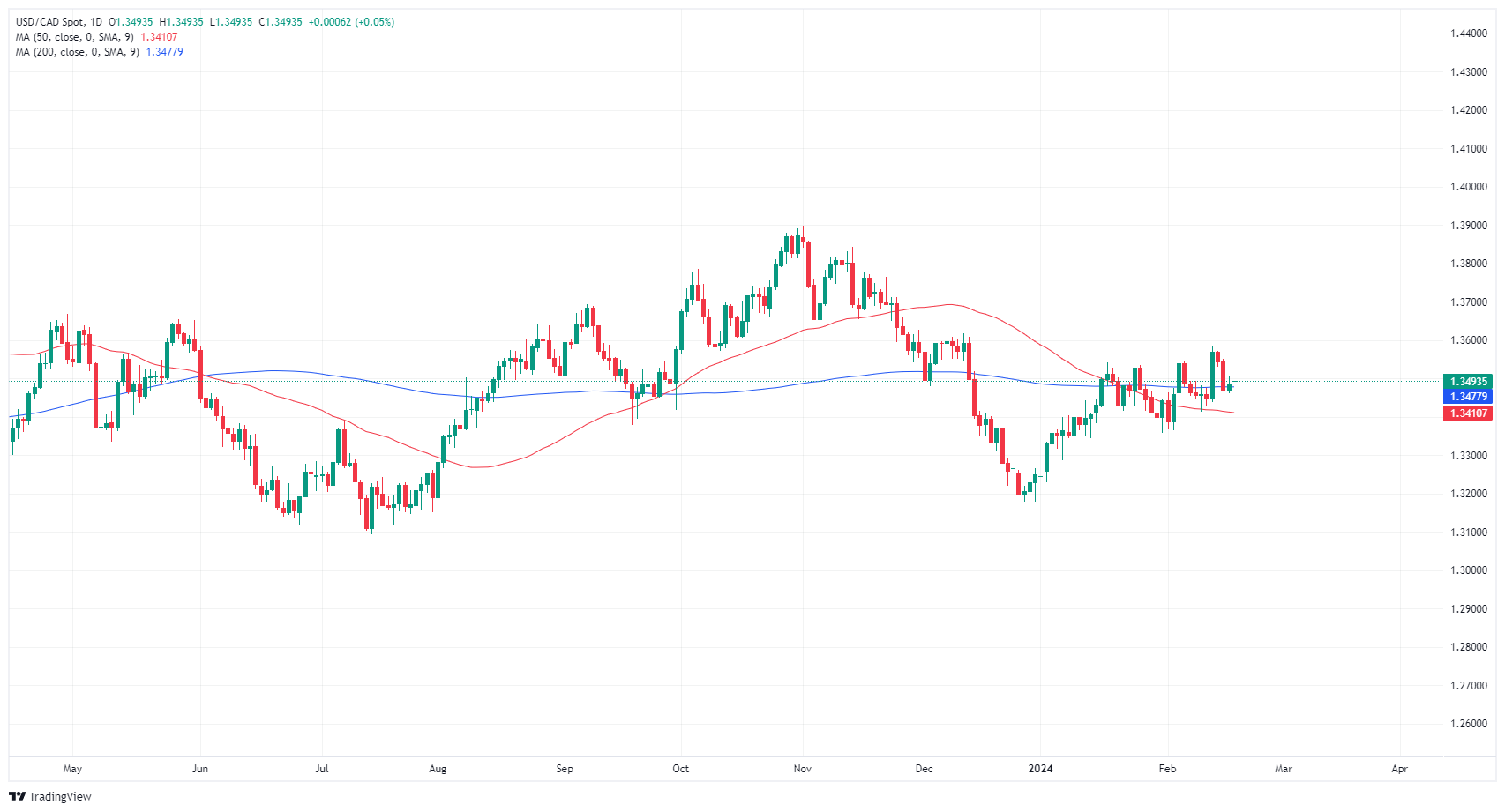- Thin Monday market churn as traders wait for big data prints this week.
- Canada, US both have bank holidays on Monday, throttling trading volumes.
- Tuesday brings Canadian CPI inflation, US FOMC Meeting Minutes on Wednesday.
The Canadian Dollar (CAD) is stuck in a near-term technical range as the new trading week kicks off with a thin market profile. Canadian and US financial institutions are dark on Monday, with two-thirds of Canadians taking the day off. Canada’s financial sector, specifically the Toronto Stock Exchange, is closed for the day. The US is also observing Presidents’ Day, and American institutions will start the new trading week on Tuesday.
Canada brings another Consumer Price Index (CPI) inflation print on Tuesday, and broader markets will be keeping a close eye on Wednesday’s Federal Open Market Committee (FOMC) Meeting Minutes as investors look out for how close the US Federal Reserve (Fed) is to cutting interest rates.
Daily digest market movers: Canadian Dollar churns in flat-sided markets
- The Canadian Raw Material Price Index rose 1.2% in January versus December’s -4.9%.
- Canadian MoM Industrial Product Prices shrank a scant -0.1% in January compared to December’s -1.6% (revised slightly from -1.5%).
- Both metrics are decidedly low-impact, barely moved the needle despite Raw Materials posting a fourth straight month in contraction territory.
- Tuesday’s YoY Canadian CPI inflation is expected to tick down slightly to 3.3% from the previous period’s 3.4%.
- MoM Canadian CPI inflation is expected to rebound to 0.4% in January from December’s -0.3%.
- Canada CPI Preview: Inflation likely eased in January.
- Canadian Retail Sales slated for Thursday are expected to show a MoM rebound to 0.8% in December compared to November’s -0.2%.
- Wednesday’s FOMC Meeting Minutes will pull the veil back on the Fed’s internal discussions about the US central bank’s interest rate stance.
- According to the CME’s FedWatch Tool, money markets are expecting a first rate trim from the Fed in June, with over 90% odds of another rate cut in July.
Canadian Dollar price today
The table below shows the percentage change of Canadian Dollar (CAD) against listed major currencies today. Canadian Dollar was the weakest against the New Zealand Dollar.
| USD | EUR | GBP | CAD | AUD | JPY | NZD | CHF | |
| USD | 0.16% | 0.18% | 0.10% | 0.04% | 0.05% | -0.12% | 0.12% | |
| EUR | -0.16% | 0.02% | -0.06% | -0.12% | -0.11% | -0.28% | -0.04% | |
| GBP | -0.18% | -0.01% | -0.08% | -0.14% | -0.12% | -0.29% | -0.05% | |
| CAD | -0.10% | 0.06% | 0.06% | -0.06% | -0.05% | -0.22% | 0.02% | |
| AUD | -0.02% | 0.14% | 0.13% | 0.08% | 0.03% | -0.14% | 0.10% | |
| JPY | -0.05% | 0.11% | 0.15% | 0.05% | -0.01% | -0.16% | 0.08% | |
| NZD | 0.12% | 0.28% | 0.29% | 0.22% | 0.16% | 0.17% | 0.25% | |
| CHF | -0.13% | 0.04% | 0.05% | -0.03% | -0.08% | -0.08% | -0.25% |
The heat map shows percentage changes of major currencies against each other. The base currency is picked from the left column, while the quote currency is picked from the top row. For example, if you pick the Euro from the left column and move along the horizontal line to the Japanese Yen, the percentage change displayed in the box will represent EUR (base)/JPY (quote).
Technical analysis: Canadian Dollar mixed on quiet Monday
The Canadian Dollar (CAD) spreads on Monday, mixed against the major currency basket at the start of the new trading week. The CAD is up a scant tenth of a percent against the Euro (EUR) and the Pound Sterling (GBP) but down a fifth of a percent against the broadly-recovering New Zealand Dollar (NZD) on Monday.
The USD/CAD is cycling within near-term technical boundaries near 1.3500, and the pair remains just north of a supply zone between 1.3440 and 1.3420. The pair spent most of the last week closing last Tuesday’s Fair Value Gap (FVG), and traders will be looking for a break of structure to bring the USD/CAD back into buying territory below 1.3460.
USD/CAD remains hampered by the 200-day Simple Moving Average (SMA) at 1.3478, and near-term price action is finding thin but steady technical support from the 50-day SMA near 1.3410.
USD/CAD hourly chart
USD/CAD daily chart
Canadian Dollar FAQs
The key factors driving the Canadian Dollar (CAD) are the level of interest rates set by the Bank of Canada (BoC), the price of Oil, Canada’s largest export, the health of its economy, inflation and the Trade Balance, which is the difference between the value of Canada’s exports versus its imports. Other factors include market sentiment – whether investors are taking on more risky assets (risk-on) or seeking safe-havens (risk-off) – with risk-on being CAD-positive. As its largest trading partner, the health of the US economy is also a key factor influencing the Canadian Dollar.
The Bank of Canada (BoC) has a significant influence on the Canadian Dollar by setting the level of interest rates that banks can lend to one another. This influences the level of interest rates for everyone. The main goal of the BoC is to maintain inflation at 1-3% by adjusting interest rates up or down. Relatively higher interest rates tend to be positive for the CAD. The Bank of Canada can also use quantitative easing and tightening to influence credit conditions, with the former CAD-negative and the latter CAD-positive.
The price of Oil is a key factor impacting the value of the Canadian Dollar. Petroleum is Canada’s biggest export, so Oil price tends to have an immediate impact on the CAD value. Generally, if Oil price rises CAD also goes up, as aggregate demand for the currency increases. The opposite is the case if the price of Oil falls. Higher Oil prices also tend to result in a greater likelihood of a positive Trade Balance, which is also supportive of the CAD.
While inflation had always traditionally been thought of as a negative factor for a currency since it lowers the value of money, the opposite has actually been the case in modern times with the relaxation of cross-border capital controls. Higher inflation tends to lead central banks to put up interest rates which attracts more capital inflows from global investors seeking a lucrative place to keep their money. This increases demand for the local currency, which in Canada’s case is the Canadian Dollar.
Macroeconomic data releases gauge the health of the economy and can have an impact on the Canadian Dollar. Indicators such as GDP, Manufacturing and Services PMIs, employment, and consumer sentiment surveys can all influence the direction of the CAD. A strong economy is good for the Canadian Dollar. Not only does it attract more foreign investment but it may encourage the Bank of Canada to put up interest rates, leading to a stronger currency. If economic data is weak, however, the CAD is likely to fall.
